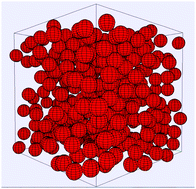Swelling, structure, and phase stability of compressible microgels
Abstract
Microgels are soft colloidal particles that, when dispersed in a solvent, swell and deswell in response to changes in environmental conditions, such as temperature, concentration, and pH. Using Monte Carlo simulation, we model bulk suspensions of microgels that interact via Hertzian elastic interparticle forces and can expand or contract via trial moves that allow particles to change size in accordance with the Flory–Rehner free energy of cross-linked polymer gels. We monitor the influence of particle compressibility, size fluctuations, and concentration on bulk structural and thermal properties by computing particle swelling ratios, radial distribution functions, static structure factors, osmotic pressures, and freezing densities. For microgels in the nanoscale size range, particle compressibility and associated size fluctuations suppress crystallization, shifting the freezing transition to a higher density than for the hard-sphere fluid. As densities increase beyond close packing, microgels progressively deswell, while their intrinsic size distribution grows increasingly polydisperse.



 Please wait while we load your content...
Please wait while we load your content...